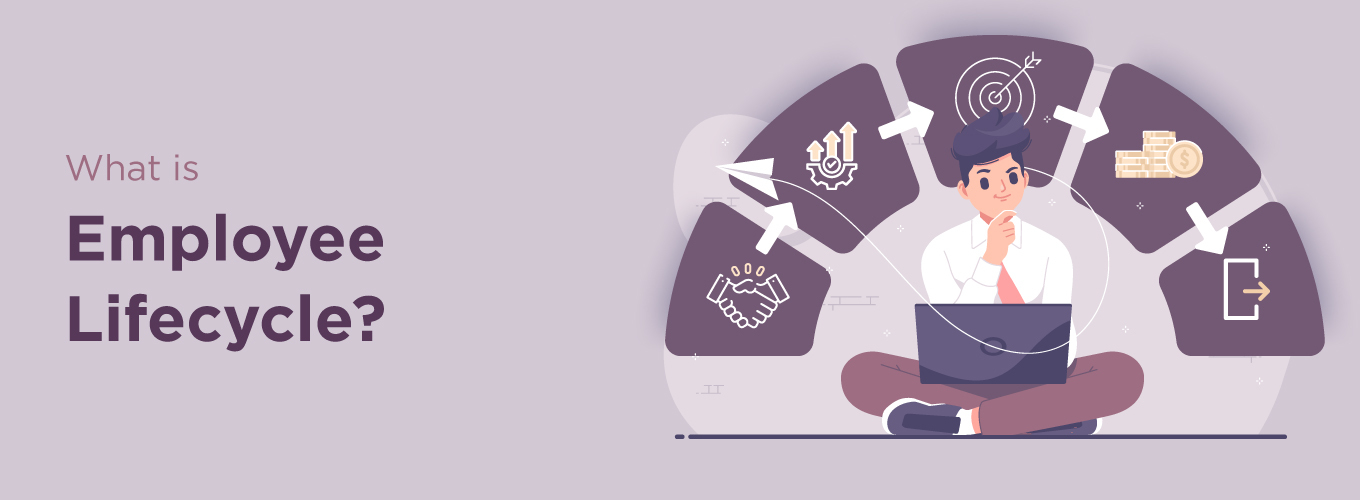What is Employee life cycle?
Employee life cycle refers to all the stages through which an employee passes in a company starting from hiring to leave taking. This is a cyclic process that covers different levels of experience for an employee in a business organisation. Initially, it starts with the recruitment stage where potential job holders are identified, interviewed, and recruited. On-boarding means the starting phase when new employees are acquainted through a systematic process with the organisation’s mission, goals, objectives, culture, values and procedures necessary for successful integration into the position.
Performance Management begins during this stage involving setting goals, regular feedback and evaluations to align with organisational needs.
Engagement of the employees happens to be important throughout the cycle when it helps promote an encouraging workplace and develop feelings of belonging and dedication among the labor force.
Transitions that signal an advancement phase for employees such as promotions, lateral movement, and role changes occur in response to changing circumstances. Separation or exit is the final phase of the cycle in which an employee can exit by way of resignation, retirement or otherwise. Exit interviews and knowledge transfer as part of the offboarding process help employees leave gracefully and give useful feedback on how the organisation should improve.
This is a cyclic process where an organisation seeks the best way of attracting, developing, engaging, and retaining talents through every step of the cycle. Through comprehensive management of the employee life cycle, organisations can enable the growth of employees, contribute to their productivity and enhance their feelings of satisfaction. This is vital to the company’s success and recognition by employees as employers of choice.
Table of Contents
What are the stages of the Employee life cycle?
Most important stages of the Employee life cycle:
Recruitment: It covers recruitment, interrogation, and picking available candidates ready to settle a vacancy.
Onboarding: Orientation means introducing the new employees into the company’s culture, policies, processes and work environment.
Performance Management: Setting objectives, evaluating performance according to set performance metrics and providing feedback).
Professional Development: Training, skill development programs and succession mechanisms through which an employee manages success in his/her job as well as growth within the organisation.
Employee Engagement: Building positive worksite development with open communications, rewards and motivators towards enhancing loyalty, morale and employee dedication.
Advancement: Employee development by giving promotion, career progression or intra-organisational moves that recognize their growth and contributions within an organisation.
Departure or Exit: This occurs when an employee exits the firm as a result of a volunteer resignation, retirement or otherwise. Leaves employees who take part during off boarding processes such as exit interview, knowledge transfer smiling as they depart and go away from the company.
Why is the Employee life cycle important?
The Employee Life Cycle is important because it becomes a directional map guiding enterprises toward making their employee travels interwoven and fascinating. It offers a critical touchpoint from recruitment to exit strategy spanning different parts of the company. Managing this cycle effectively has a great impact on employee satisfaction, retention, and job performance.
Organisations can improve recruitment by considering each phase of the process and getting the best talents into the organisation at the onset. The stages of performance management and professional development build on each other with a focus on training and developing employees by their abilities, leading to better skills and productivity. Additionally, an intensive program of employee involvement throughout the period creates a good working environment, promoting devotion and dedication among workers.
This helps in discovering and dealing with bottlenecks/improvement opportunities on strategic life cycle phase management. When employees leave during the exit, it is an opportunity to provide insights for better improvement of processes, correction, and amendment for quality service delivery.
To this end, appropriate management of the Employee life cycle enhances the organisation’s employer brand by drawing quality personnel and building a company with the best employer brand recognition. Finally, the Employee life cycle helps develop talents, improves performance, and creates a favourable organisational climate that eventually leads to organisational prosperity and growth.
What are the 7 stages of the Employee life cycle?
The 7 stages of the employee life cycle typically include:
Recruitment: Recruiting is a process that entails getting, and attracting through advertisements, or headhunting of candidates for vacant positions in an organisation.
Onboarding: The integration of new employees into the organisation, making them aware of its culture, work standards, policies and procedures, and what they are expected to do for the organisation.
Performance Management: Objective setting, progress monitoring, giving feedback and evaluating employees’ performance in line with organisational objectives.
Development: Training on professionalism, skills improvement and career development allows an employee to attain excellence and climb up the ladder.
Retention: Policies and programs such as those intended to retain great performers, boost motivation, and address reasons for attrition.
Transition: Internal transitions – like promotions, role changes, transfers within and between offices etc.
Offboarding: Exit management, such as exit interviews, knowledge transfer, and making sure that the employee exits the company smoothly.
Conclusion
The Employee Lifecycle ranges from recruitment, onboarding, development, retention, and offboarding. It is a process that begins with hiring and ends with departure but is focused on creating a good work culture and making the most of the employee potential. Finally, the employee lifecycle is beneficial to organizational achievement via training and development and high employee satisfaction.
Frequently asked questions
1. What is the Employee life cycle in HRM?
The employee life cycle is important in HRM, it describes the different phases that a worker goes through within the company. It captures the entire process beginning with an individual’s recruitment into the company or hiring leading right through the integration, development, and separation of that person out of the outfit.
2. Role of HR in the Employee Life Cycle?
During an employee life cycle, HR is at every step from recruitment to offboarding providing guidance and assistance.
3. What are the different types of stages in the Employee life cycle?
Employee Lifecycle: Attraction, Hiring, Onboarding, Performance Management, Learning, Engagement, Career Growth, Retention, Transition, Exit. In summary, it’s the holistic journey from recruitment to departure, ensuring a positive and productive employee experience.









